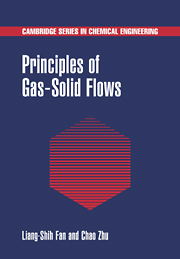Preface
Published online by Cambridge University Press: 27 October 2009
Summary
Gas–solid flows are involved in numerous industrial processes and occur in various natural phenomena. For example, in solid fuel combustion, gas–solid flows are involved in pulverized coal combustion, solid waste incineration, and rocket propellant combustion. Gas–solid flows are encountered in pneumatic conveying of particulates commonly used in pharmaceutical, food, coal, and mineral powder processing. Fluidization is a common gas–solid flow operation with numerous important applications such as catalytic cracking of intermediate hydrocarbons, and Fischer–Tropsch synthesis for chemicals and liquid fuel production. Gas–solid flows occur in gas–particle separations, as exemplified by cyclones, electrostatic precipitators, gravity settling, and filtration operations. Fine powder–gas flows are closely associated with material processing, as in chemical vapor deposition for ceramics and silicon production, plasma coating, and xerography. In heat transfer applications, gas–solid flows are involved in nuclear reactor cooling and solar energy transport using graphite suspension flows. Solid dispersion flows are common in pigment sprays, dust explosions and settlement, and nozzle flows. The natural phenomena accompanied by gas–solid flows are typified by sand storms, moving sand dunes, aerodynamic ablation, and cosmic dusts. The optimum design of the industrial processes and accurate account of the natural phenomena that involve gas–solid flows as exemplified previously require a thorough knowledge of the principles governing these flows.
This book is intended to address basic principles and fundamental phenomena associated with gas–solid flows, as well as characteristics of selected gas–solid flow systems. It covers the typical range of particle sizes of interest to gas–solid flows, i.e., 1 μm–10 cm, recognizing that flow characteristics for submicrometer particles are also of great industrial importance.
- Type
- Chapter
- Information
- Principles of Gas-Solid Flows , pp. xv - xviiiPublisher: Cambridge University PressPrint publication year: 1998
- 1
- Cited by



